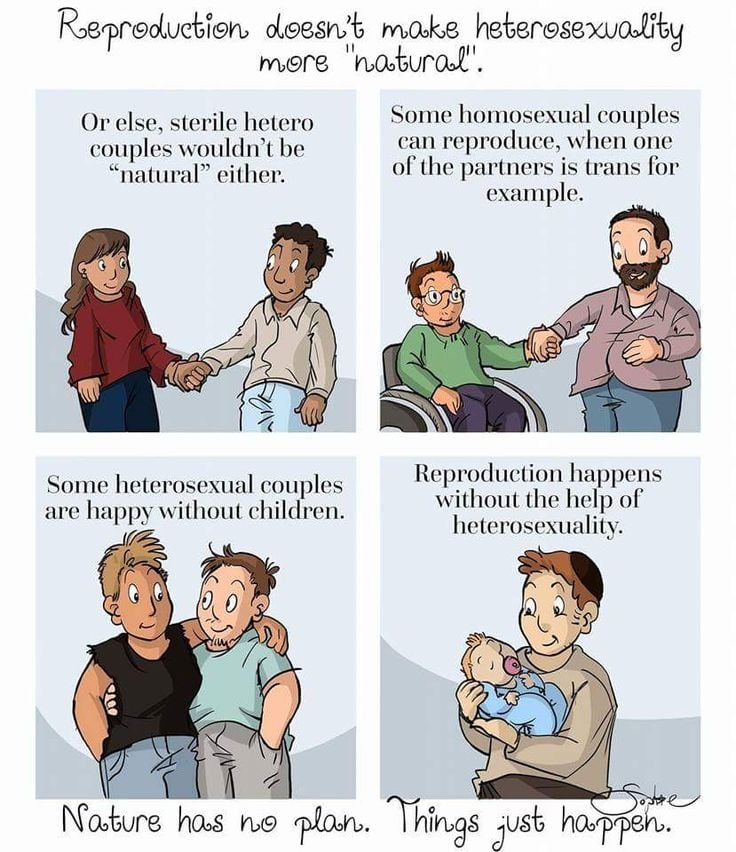
Does nature order human sexuality to marriage between man and a woman?
A popular meme that you might have seen on your Facebook feed says no:

I want to focus on the top left panel, which expresses a favorite idea of same-sex-marriage advocates. If, they say, homosexual unions are “wrong” because they can’t create life, then sterile marriages must be wrong, too.
How do we think this through?
Equivocation is the game
First, the argument commits the equivocation fallacy. Equivocation is the use of the same term in two or more different senses in the course of an argument. For example, the song “Have Yourself a Merry Little Christmas” says, “Make the Yuletide gay.” It would be fallacious to respond, “That’s absurd. Sexual preference shouldn’t have anything to do with enjoying a holiday.” Obviously the word gay in the song is not being used in the homosexual sense, but in the sense of being joyful and merry.
The meme commits this fallacy because inability to generate children for sterile heterosexual couples is not the same as the inability to generate children for homosexual couples. The argument uses the term inability equivocally.
When a homosexual couple are unable to generate children after four years, no one wonders why. That’s because the nature of their sexual activity is not baby-making—that is to say, it’s not the type of activity that is naturally ordered toward producing children. It is no more baby-making activity than playing tennis, even though the couple use their sexual organs.
On the other hand, a heterosexual couple who, due to age or medical condition or some other factor, cannot conceive a child, do engage in baby-making activity. The genital union that they achieve is the kind of activity that nature ordains to produce children. And if it were not for the unintended (accidental) physical defect, the natural end of procreation would be achieved.
So a heterosexual couple’s inability to generate children involves an impeded natural ability, whereas a homosexual couple’s inability to generate children involves no natural ability. To use an example from my friend and colleague Trent Horn, the former is analogous to a paralyzed man who is unable to walk—an external factor is frustrating the achievement of a natural end. The latter is analogous to a man trying to fly by flapping his arms.
Since the inability to generate children is different in kind for a heterosexual and homosexual couple, they should not be spoken of or treated as if they were the same. To do so would be as silly as saying a paralyzed man and a snake are the same since they both can’t walk.
Sexual perversion
Furthermore, unintended sterile heterosexual sex does not actively frustrate the procreative end of sex like homosexual acts do. The latter involves a perversion, and thus is unnatural, whereas the former does not.
The term unnatural in the moral sense refers to actions that violate human nature. If nature gives humans faculty A so that humans might achieve the end of B, then it would be a violation of nature’s design, and thus unnatural, to use A in a manner that actively frustrates the realization of B. (See Ed Feser’s article “In Defense of The Perverted Faculty Argument” for more.)
Sexual activity among members of the same sex fits the unnatural bill. It uses the sexual faculties (A) in a manner that actively frustrates the realization of the ends (B) for which sex exists, namely, procreation and union. It violates the procreative end by taking sexual arousal to a climax where procreation is impossible in principle. It also violates the unitive end, since the union for which sex exists is conjugal; that is, ordered to male-female complementarity and to the bond of marriage.. Such activity is a perversion of the natural powers inherent in human beings; hence it is unnatural.
Sex for a sterile heterosexual couple, or for couples who engage in the sexual act during the infertile period of the woman’s cycle, involves no perversion. The couple place no impediment in the way of realizing sex’s natural end of procreation. It is not that the couple are not following nature, but that nature, having been followed, fails in the work proper to her.
To use the Scholastic jargon, the physical evil (failure to conceive) is not due to a moral evil (the willful disabling of the act).
Per se what?
A final response is that even for sterile heterosexual couples sexual intercourse retains its natural ordering—that is to say, it is still for the sake of procreation. In the language of the philosophers, the act retains its per se destinatus (its intrinsic destination). The act itself still has procreation as its destination; it is still the kind of act that is naturally ordained to achieve procreation.
Perhaps some examples will help illustrate this. Consider a baseball team, structured to win baseball games. Does its failure to win a game mean that it is no longer oriented toward winning games? No. What about an eye that can no longer see due to natural or accidental causes? Does that mean the eye by its nature is no longer for the sake of seeing? Of course not!
The body’s process of digestion serves as another example. Such biological activity involves many different parts—salivation, chewing, swallowing, stomach action, and finally intestinal absorption of nutrients. Each of these parts has the nourishment of the organism as its destination or goal, even if the final end of nutrient absorption is not achieved—whether in full or in part. In this case, the digestive parts would still retain their per se destinatus.
Similarly, even though the conjugal act for a sterile heterosexual couple (or a couple that have sex during infertile periods) does not achieve its final destination of conception, the act still is “in itself” (per se) ordered toward that goal. The structure of the reproductive act remains the same because the sexual faculties are used in accord with nature’s design, and thus the act is natural. And as the late Michael Cronin concludes, since “the circumstances necessary for the due performance of our own share of the act are present, the act is lawful” (Science of Ethics Vol. I).
Conclusion
The argument that the meme puts forward is a classic case of comparing apples and oranges. As absurd as the comparison is, those who have used it have been successful in persuading people to think that Christians are hypocrites for condemning homosexual acts, since they don’t condemn unintended sterile heterosexual sex.
But as the above arguments show, such a comparison is false. Therefore, the two different kinds of activity should not be spoken of or treated as if they were the same. Similar principles apply to the other corners of the meme. Nature still has a plan for human sexuality, and it doesn’t involve homosexual acts.



